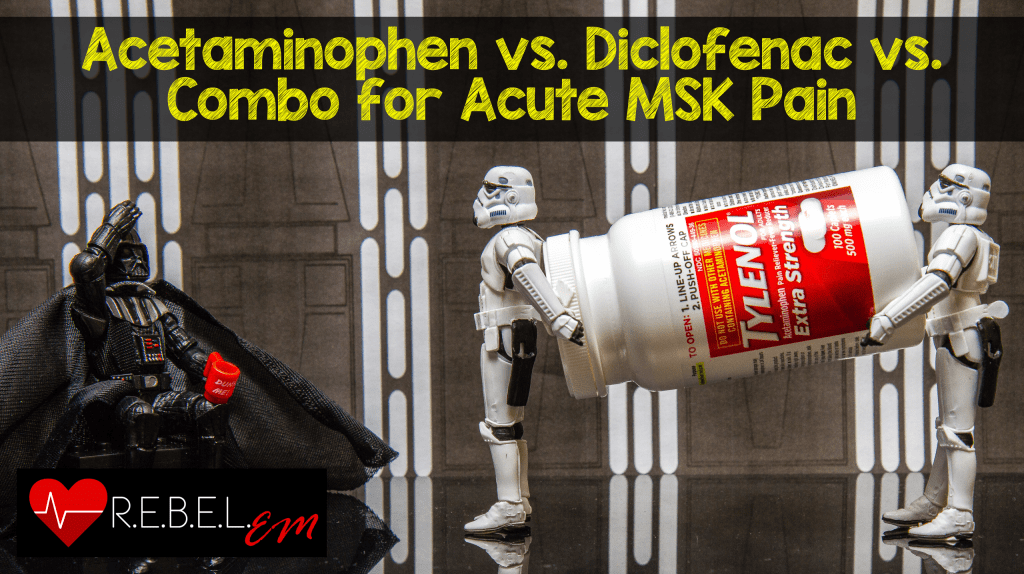 Background: Acute, minor musculoskeletal injuries (i.e. non-fracture or dislocations) are frequently seen in the Emergency Department. Aside from ruling out a more severe injury, management often focuses on pain relief or mitigation of pain. Though many analgesic agents exist, acetaminophen and nonsteroidal anti-inflammatory drugs (NSAIDs) are commonly used for this indication. Both have important side effects or potential for adverse events that must be considered when prescribing them. Finally, it is unclear if combining the two classes of medications is beneficial.
Background: Acute, minor musculoskeletal injuries (i.e. non-fracture or dislocations) are frequently seen in the Emergency Department. Aside from ruling out a more severe injury, management often focuses on pain relief or mitigation of pain. Though many analgesic agents exist, acetaminophen and nonsteroidal anti-inflammatory drugs (NSAIDs) are commonly used for this indication. Both have important side effects or potential for adverse events that must be considered when prescribing them. Finally, it is unclear if combining the two classes of medications is beneficial.
Clinical Question: Is acetaminophen alone non-inferior to either diclofenac or the combination of diclofenac and acetaminophen in the treatment of acute musculoskeletal pain in trauma.
Article: Ridderikhof ML et al. Acetaminophen or nonsteroidal anti-inflammatory drugs in acute musculoskeletal trauma: a multicenter, double-blind, randomized, clinical trial. Ann Emerg Med 2017. PMID: 29033294
Population: Patients > 18 years of age presenting to 2 university hospitals, an urgent care center and 2 general practices in the Netherlands with non-penetrating, minor musculoskeletal, extremity trauma occurring within 48 hours of presentation
Intervention: 1:1:1 randomization to acetaminophen 4000 mg/day, diclofenac 150 mg/day or acetaminophen 4000 mg/day + diclofenac 150 mg/day
Outcomes:
- Primary: Between-group differences in numeric rating scale (NRS) pain scores at rest and with movement at 90 minutes compared with baseline pain score (noninferiority margin of 0.75 NRS points)
- Secondary: Differences in pain scores at 30 and 60 minutes compared with baseline and pain during 3 consecutive days.
Design: Multicenter, double-blind, randomized non-inferiority trial
Excluded: Previous analgesia treatment for the same injury, self-inflicted injury, presence of a wound, joint dislocation or multiple injuries, presence of a fracture, daily use of an NSAID or acetaminophen, known pregnancy, previous GI hemorrhage or perforation, active/recurrent peptic ulceration or bleeding, history of asthma exacerbation after NSAID or acetylsalicylic acid use, severe cardiac failure, liver cirrhosis, severe renal insufficiency, physical, visual or cognitive impairment or non-Dutch speaking.
Primary Results:
- 547 patients randomized in 1:1:1 fashion
- 19 patients excluded after randomization (mostly due to fractures)
- 20 patients with unknown primary outcome (evenly balanced between groups)
- Pain scores decreased in all groups after administration of medications
Critical Findings:
- Between group differences in NRS at 90 minutes (primary outcome)
- No clinically significant difference in pain reduction
- All differences in pain relief less than the noninferiority margin
- Between group differences in NRS at 30 and 60 minutes (secondary outcome)
- No significant between group differences
- There were no between group differences in pain scores at day 1 or day 3 (secondary outcome)
- No significant differences in patient satisfaction
Strengths:
- Study asks a clinically important question with limited high-quality current evidence
- Multicenter study with multiple injury types
- Double-dummy design: all groups given two sets of pills to take with identical placebo pills filling in for active medications
- Patients, health care staff and outcome assessors were all blinded to the intervention
- Non-inferiority margin set below the clinically significant NRS change to ensure that missing a smaller difference would not be clinically relevant
- Performed both intention to treat and per-protocol analysis (no difference in either analysis)
- Loss to follow up for the primary outcome was low
Limitations:
-
- Long list of exclusion criteria that makes results difficult to apply to everyday practice
- More than half of appropriate patients refused to participate in the study
- There is no delineation in this study of how many patients presented at hours 0-24 or beyond 24 hours (though all were within 48 hours of injury). Prior studies have shown that combination treatment may be more effective at < 24 hours
- Study collected patients both in ED and outpatient settings but no specification of how many patients in each setting. It is unclear if primary care presentations can be generalized to ED presentations
- Loss to follow up in phase 2 of the study (outcomes at day 1 and 3) was 15%
- Study underpowered to detect differences in adverse reactions and, one of the main adverse reactions (GI upset with NSAIDs) was mitigated by addition of a PPI
Other Issues:
- Diclofenac is not widely used in the US due to it requiring a prescription. However, prior studies have not shown a significant difference between diclofenac and ibuprofen in analgesic efficacy.
Authors Conclusions:
“Pain treatment with acetaminophen was not inferior to that with diclofenac or the combination of acetaminophen and diclofenac in acute minor musculoskeletal extremity trauma, both in rest and with movement.”
Our Conclusions: We agree with the author’s conclusions. Acetaminophen appears to be noninferior to both diclofenac and a combination of diclofenac and acetaminophen in the treatment of acute, minor musculoskeletal pain.
Potential to Impact Current Practice: Based on this data, there does not appear to be a benefit to adding diclofenac to acetaminophen in the treatment of acute musculoskeletal pain. While this study cannot speak to the risk of adverse events of diclofenac, it’s addition, based on this data, would only expose the patient to harm without added benefit. Despite these findings, we do not strongly recommend against the use of combination treatment as further large, prospective trials would be useful in hashing out the utility of combination treatment.
Bottom Line: Routinely adding diclofenac to acetaminophen in the treatment of acute, minor musculoskeletal pain does not appear to lead to improved short-term analgesic benefits.
Expert Commentary: Sergey Motov, MD
My take: Very well conducted non-inferiority trial that demonstrated lack of appreciable analgesic differences between apap group and diclofenac group and combo group.
While, as you mentioned, this study calls for abandoning routine prescribing of combo of apap/nsaid for minor acute MSK pain in the ED, more randomized trials are warranted to evaluate analgesic superiority of apap/ibuprofen combinations for short-term analgesia in the ED and at discharge.
Do not throw this valuable analgesic combination out of ED window just yet as there is data clearly supporting its use for acute postoperative, pediatric and dental pain.
Here are some specific thoughts on the methodology and results from Dr. Motov:
I like the way you have presented the study and I agree with your conclusion and bottom line. As far as implications for current practice here are few things I would like to point out:
1. To classify minor injury by NRS, the widely acceptable range is 1-3 or 1-4. Patients in the study had an average NRS of 4.5 at rest and 7.35 on movement which is not minor.
2. Inclusion criteria stated that patients sustained injury within 48h of presentation to the ED: From a pharmacological perspective, NSAID’s and NSAID’s/APAP combinations are better at relieving pain in immediate acute 0-24h pain period. It is unclear how many patients presented to the ED within this time frame. It is possible that at 48h mark APAP could have similar analgesic efficacy to combo.
3. The change in pain score across three groups at rest and on movement is clinically so insignificant and NNT fairly large that authors should have concluded that despite proven non-inferiority (which btw was done perfectly) none of the arms provided clinically meaningful change in pain score in patients with MODERATE acute MSK pain.
4. Of note, both APAP and Diclofenac were dosed above their analgesic ceiling and even so, still did not provide a clinically significant analgesic response.
5. Underpowered for side effects but I do not think 4g q6h x3 days is a routine practice in ED’s for minor MSK pain
6. While I agree that Dilclofenac is similar to Ibuprofen, it would be interesting to see a similar study with Ibuprofen
7. Data from several Cochrane reviews with respect to combo of apap/ibuprofen demonstrates analgesics superiority to apap alone:
- http://www.ncbi.nlm.nih.gov/pubmed/20142348
- http://www.ncbi.nlm.nih.gov/pubmed/25170006
- http://www.ncbi.nlm.nih.gov/pubmed/11881888
Post Peer Reviewed By: Salim Rezaie (Twitter: @srrezaie)



